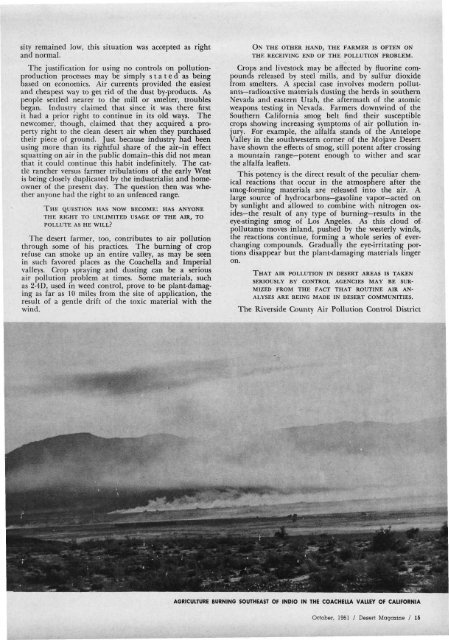OUTDOOR SOUTHWEST - Desert Magazine of the Southwest
OUTDOOR SOUTHWEST - Desert Magazine of the Southwest
OUTDOOR SOUTHWEST - Desert Magazine of the Southwest
You also want an ePaper? Increase the reach of your titles
YUMPU automatically turns print PDFs into web optimized ePapers that Google loves.
sity remained low, this situation was accepted as right<br />
and normal.<br />
The justification for using no controls on pollutionproduction<br />
processes may be simply stated as being<br />
based on economics. Air currents provided <strong>the</strong> easiest<br />
and cheapest way to get rid <strong>of</strong> <strong>the</strong> dust by-products. As<br />
people settled nearer to <strong>the</strong> mill or smelter, troubles<br />
began. Industry claimed that since it was <strong>the</strong>re first<br />
it had a prior right to continue in its old ways. The<br />
newcomer, though, claimed that <strong>the</strong>y acquired a property<br />
right to <strong>the</strong> clean desert air when <strong>the</strong>y purchased<br />
<strong>the</strong>ir piece <strong>of</strong> ground. Just because industry had been<br />
using more than its rightful share <strong>of</strong> <strong>the</strong> air-in effect<br />
squatting on air in <strong>the</strong> public domain-this did not mean<br />
that it could continue this habit indefinitely. The cattle<br />
rancher versus farmer tribulations <strong>of</strong> <strong>the</strong> early West<br />
is being closely duplicated by <strong>the</strong> industrialist and homeowner<br />
<strong>of</strong> <strong>the</strong> present day. The question <strong>the</strong>n was whe<strong>the</strong>r<br />
anyone had <strong>the</strong> right to an unfenced range.<br />
THE QUESTION HAS NOW BECOME: HAS ANYONE<br />
THE RIGHT TO UNLIMITED USAGE OF THE AIR, TO<br />
POLLUTE AS HE WILL?<br />
The desert farmer, too, contributes to air pollution<br />
through some <strong>of</strong> his practices. The burning <strong>of</strong> crop<br />
refuse can smoke up an entire valley, as may be seen<br />
in such favored places as <strong>the</strong> Coachella and Imperial<br />
valleys. Crop spraying and dusting can be a serious<br />
air pollution problem at times. Some materials, such<br />
as 2-4D, used in weed control, prove to be plant-damaging<br />
as far as 10 miles from <strong>the</strong> site <strong>of</strong> application, <strong>the</strong><br />
result <strong>of</strong> a gentle drift <strong>of</strong> <strong>the</strong> toxic material with <strong>the</strong><br />
wind.<br />
ON THE OTHER HAND, THE FARMER IS OFTEN ON<br />
THE RECEIVING END OF THE POLLUTION PROBLEM.<br />
Crops and livestock may be affected by fluorine compounds<br />
released by steel mills, and by sulfur dioxide<br />
from smelters. A special case involves modern pollutants—radioactive<br />
materials dusting <strong>the</strong> herds in sou<strong>the</strong>rn<br />
Nevada and eastern Utah, <strong>the</strong> aftermath <strong>of</strong> <strong>the</strong> atomic<br />
weapons testing in Nevada. Farmers downwind <strong>of</strong> <strong>the</strong><br />
Sou<strong>the</strong>rn California smog belt find <strong>the</strong>ir susceptible<br />
crops showing increasing symptoms <strong>of</strong> air pollution injury.<br />
For example, <strong>the</strong> alfalfa stands <strong>of</strong> <strong>the</strong> Antelope<br />
Valley in <strong>the</strong> southwestern corner <strong>of</strong> <strong>the</strong> Mojave <strong>Desert</strong><br />
have shown <strong>the</strong> effects <strong>of</strong> smog, still potent after crossing<br />
a mountain range—potent enough to wi<strong>the</strong>r and scar<br />
<strong>the</strong> alfalfa leaflets.<br />
This potency is <strong>the</strong> direct result <strong>of</strong> <strong>the</strong> peculiar chemical<br />
reactions that occur in <strong>the</strong> atmosphere after <strong>the</strong><br />
smog-forming materials are released into <strong>the</strong> air. A<br />
large source <strong>of</strong> hydrocarbons—gasoline vapor—acted on<br />
by sunlight and allowed to combine with nitrogen oxides—<strong>the</strong><br />
result <strong>of</strong> any type <strong>of</strong> burning—results in <strong>the</strong><br />
eye-stinging smog <strong>of</strong> Los Angeles. As this cloud <strong>of</strong><br />
pollutants moves inland, pushed by <strong>the</strong> westerly winds,<br />
<strong>the</strong> reactions continue, forming a whole series <strong>of</strong> everchanging<br />
compounds. Gradually <strong>the</strong> eye-irritating portions<br />
disappear but <strong>the</strong> plant-damaging materials linger<br />
on.<br />
THAT AIR POLLUTION IN DESERT AREAS IS TAKEN<br />
SERIOUSLY BY CONTROL AGENCIES MAY BE SUR-<br />
MIZED FROM THE FACT THAT ROUTINE AIR AN-<br />
ALYSES ARE BEING MADE IN DESERT COMMUNITIES.<br />
The Riverside County Air Pollution Control District<br />
AGRICULTURE BURNING SOUTHEAST OF INDIO IN THE COACHELLA VALLEY OF CALIFORNIA<br />
October, 1961 / <strong>Desert</strong> <strong>Magazine</strong> / 15

















